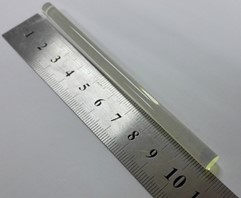Yb3+/Al3+-co-doped silica fibers are the most significant gain medium in high-power lasers to obtain the femtosecond laser pulse with 100 J peak energy. However, high melting temperature and high refractive index may restrict their application.
B2O3 can effectively lower the viscosity of glass melt and affect the optical properties of rare-earth ions. Most previous work focuses on the properties of the ytterbium doped glasses with different compositions while the underlying reasons are rarely reported.
A research team led by prof. HU Lili in Shanghai Institute of Optics and Fine Mechanics of the Chinese Academy of Sciences (SIOM, CAS) has built an intuitive model of structure and properties evolution during the substitution of SiO2 by B2O3 in Yb3+/Al3+/B3+-co-doped silica glasses. The study was published in Journal of the American Ceramic Society.
In their research, the homogeneous Yb3+/Al3+/B3+-co-doped silica glasses with various B2O3 concentration were prepared via a sol-gel method and subsequently high temperature sintered under vacuum. Yb3+-doped, Y3+/Al3+/B3+-co-doped, B3+-doped silica and borosilicate glasses were simultaneously fabricated for comparison. The network structure of Yb3+/Al3+/B3+-co-doped silica glasses was systematically analyzed via FT-IR, Raman, 29Si, 27Al and 11B Magic Angle Spinning NMR spectra, as well as 27Al{11B} and 11B{27Al} Rotational Echo Double Resonance experiments.
The generation of Yb-O-B bonds at the cost of partial Yb-O-Al/Si ones should account for the decrement in the scalar crystal field parameters, Yb3+ asymmetry degree and Yb3+ cross-sections when B2O3 was lower than 2 mol%. They found that further increased B atoms preferred to connect with Si and Al rather than Yb. Consequently, the above parameters were basically unchanged and B2O3 addition could continuously decrease the refractive index and density.
This research can provide a valuable reference to fabricate the Yb3+-doped silica fibers with low numeral aperture.
This work was supported by the National Natural Science Foundation of China, the Natural Science Foundation of Shanghai and Shanghai International Cooperation Fund.

Yb3+/Al3+/B3+-co-doped silica fiber. (Image by SIOM)
Article website:
https://doi.org/10.1111/jace.17155
Contact:
Mr. CAO Yong
General Administrative Office
Shanghai Institute of Optics and Fine Mechanics, CAS
Email: caoyong@siom.ac.cn